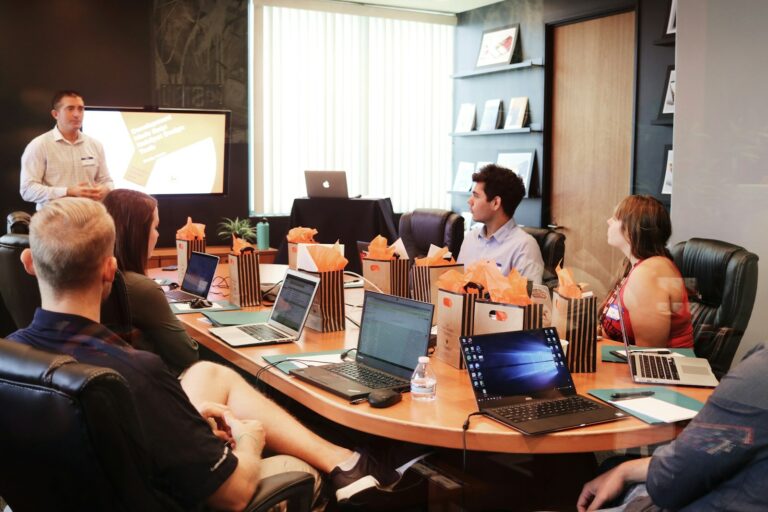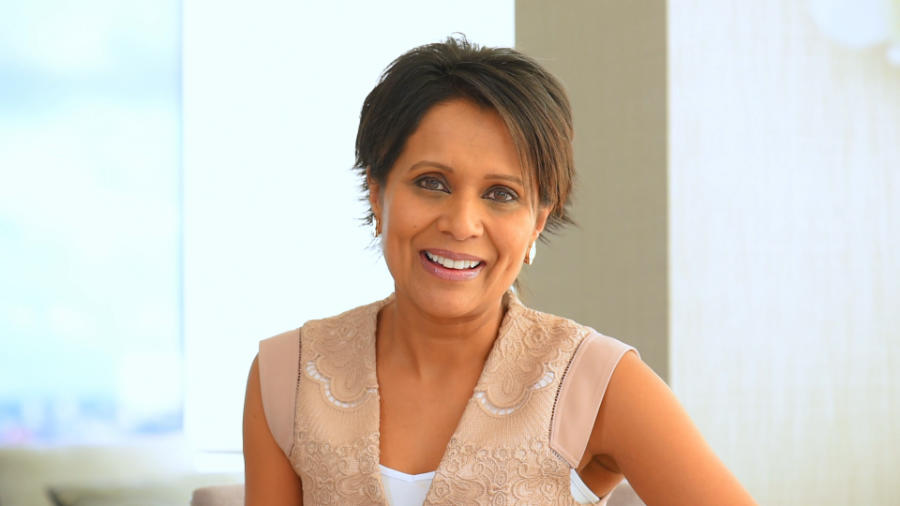How To Build Confidence For Public Speaking, According To a Seasoned News Presenter

Public speaking is a skill that many of us wish to master, but it’s often the confidence aspect that holds us back. As an executive coach and a public speaker myself, I’ve seen firsthand how a boost in confidence can transform a person’s ability to communicate their ideas effectively and captivate an audience.
I remember one of my first experiences as a reporter for ITV. The thought of standing in front of a camera, knowing that millions of viewers would be watching me on their TV screens, was daunting to say the least! I was nervous, my palms were sweaty, and my heart was racing. But I knew I had a story to tell, and I didn’t want my fear to hold me back.
So, I took a deep breath, looked into the camera, and started speaking. As I began to engage with the viewers, I noticed a shift in my confidence. I was no longer just delivering a report; I was having a conversation with the audience. That experience taught me the power of confidence in public speaking. It’s not just about delivering your message; it’s about connecting with your audience, and that requires confidence.
In this article, we’ll explore the importance of confidence in public speaking, how to build it, and how to maintain it. Whether you’re an aspiring public speaker or a seasoned professional looking to enhance your skills, this guide is for you. Let’s dive in!
Understanding Confidence in Public Speaking
Confidence in public speaking refers to the self-assuredness that a speaker possesses when delivering a speech or presentation. It is the belief in one’s ability to communicate clearly, effectively, and persuasively. Confidence is reflected in the speaker’s voice, body language, and overall demeanour. It is not just about feeling confident, but also about appearing confident to the audience.
The role of confidence in effective public speaking is significant. A confident speaker can engage the audience in ways a less self-assured one cannot. Confidence puts the audience at ease, making it easier for them to accept and understand the speaker’s message. It also helps the speaker to convey their authority on a subject, persuading the audience to trust and respect their views.
Confidence in public speaking is not something that comes naturally to everyone. It is a skill that can be developed and improved over time. Here are some key points from the article on the Throughline Group website:
- Understanding the importance of confidence in public speaking: Confidence allows you to connect with your audience, convey your key points with conviction, and get the results you seek. When you speak with assurance, others generally believe you.
- Identifying what causes a lack of confidence: This could be fear of public speaking, doubt over your expertise, or concerns about audience dynamics. Identifying these obstacles is the first step to overcoming them.
- Building confidence: This involves focusing on clarity and conviction in your delivery, displaying the right body language, and focusing on the audience rather than dwelling on potential mistakes. It also involves practising, getting feedback, attending public speaking events, and even taking public speaking courses.
- Dealing with mistakes: One of the greatest ways to bring attention to an unexpected challenge is to bring attention to it. If you happen to flub a line, forget a point, or advance to the wrong slide, calmly and confidently address it and move on.
Why It’s Important to Practise
Practice is the cornerstone of mastering any skill, and public speaking is no exception. The more you practise, the more comfortable you become with your material, your delivery, and the act of speaking itself. But how do you practise effectively?
- Identify the most important areas to improve: Start by recording a video of yourself delivering a speech. This will allow you to analyse both the verbal and non-verbal aspects of your presentation. You might notice habits you weren’t aware of, such as filler words, repeated phrases, or a lack of eye contact. Once you’ve identified areas for improvement, focus on these during your practice sessions.
- Practice in manageable chunks: Don’t try to perfect your entire speech in one go. Instead, break it down into sections and focus on one at a time. This approach reduces stress and allows for more targeted improvement.
- Focus on solutions, not problems: Instead of dwelling on what you shouldn’t do, concentrate on what you should do. For instance, if you’re using too many filler words, practice pausing whenever you feel the urge to say “um” or “uh.”
- Use technology to your advantage: Record your practice sessions and watch them back. This allows you to see yourself from the audience’s perspective and identify areas for improvement.
- Practice under different conditions: Try practising in front of a mirror, recording yourself, or even presenting via video call. Each method offers unique benefits and can help you become a more versatile speaker.
- Get feedback: If possible, practice in front of someone else and ask for their feedback. They may notice things you’ve missed and offer helpful suggestions.
Remember, the goal of practice isn’t to memorise your speech word for word. Instead, it’s to become comfortable with your material and delivery, allowing you to speak with confidence and authenticity. After years of hosting and reporting the news, I can attest to the power of practice. It was not just about standing in front of a camera, but knowing that millions would be watching me on their TV screens. The more I practised, the more natural it became, and the more confident I felt.
How to Mastering Body Language
Body language is a crucial aspect of public speaking and can significantly impact the effectiveness of your message. Here’s why it’s so important:
- Enhances Verbal Communication: Body language can reinforce or enhance what you’re saying. For example, if you’re talking about a significant achievement, standing tall and using open gestures can emphasise the importance of the event.
- Conveys Emotion: Body language can help convey emotions that words alone may not fully express. For example, a smile can show genuine happiness or approval, while a frown can indicate displeasure or disagreement.
- Engages the Audience: Effective body language can help keep your audience engaged. It can make your presentation more dynamic and interesting, preventing your audience from losing interest.
- Builds Trust: Non-verbal cues can help build trust with your audience. Consistent body language that matches your words can make you appear more authentic and credible.
- Controls the Atmosphere: The speaker’s body language can influence the atmosphere of the room. For example, relaxed and open body language can make the audience feel more comfortable and receptive to your message.
Here are some tips on how to use body language effectively to convey confidence:
- Maintain Eye Contact: Eye contact can help establish a connection with your audience and show that you’re confident and engaged.
- Use Open Gestures: Open gestures, such as spreading your arms or showing your palms, can make you appear more approachable and confident.
- Stand Tall: Good posture can convey confidence and authority. Stand tall with your shoulders back and your head held high.
- Use Facial Expressions: Your facial expressions can convey a wide range of emotions. Use them to enhance your verbal message.
- Move Around: If possible, move around the stage or room. This can make your presentation more dynamic and help maintain audience interest.
- Practice: Like any other skill, effective body language can be improved with practice. Again, try practising in front of a mirror or record yourself to identify any areas for improvement.
Remember, body language is a powerful tool in public speaking. When used effectively, it can help you deliver a more impactful and engaging presentation.
Embrace The Power of Positive Thinking
Positive thinking is a powerful tool that can significantly impact your confidence in public speaking. These powerful neuro linguistic programming (NLP) tools aren’t just about being optimistic; it’s about cultivating a mindset that embraces challenges, seeks solutions, and focuses on success.
When you approach public speaking with a positive mindset, you’re more likely to view it as an opportunity rather than a threat. You’ll see it as a chance to share your knowledge, engage with your audience, and make a difference. This shift in perspective can make the whole experience less daunting and more enjoyable.
Here are some strategies to cultivate a positive mindset:
- Visualise Success: Before your speech, take a moment to visualise yourself delivering it successfully. Imagine the audience’s positive reactions, the applause, and the sense of accomplishment you’ll feel. This mental rehearsal can boost your confidence and reduce anxiety.
- Positive Affirmations: Use positive affirmations to reinforce your confidence. Phrases like “I am a confident speaker,” or “I can deliver this speech successfully,” can help reprogram your subconscious mind and replace negative thoughts with positive ones.
- Focus on the Message, Not the Fear: Instead of focusing on your fear or anxiety, concentrate on the message you want to convey. Remember, your audience is there to hear what you have to say, not to judge you.
- Embrace Mistakes: Nobody is perfect, and mistakes are part of the learning process. Instead of fearing mistakes, embrace them as opportunities to learn and improve.
- Practice Gratitude: Be grateful for the opportunity to speak and share your ideas. Gratitude can shift your focus from fear to appreciation, creating a more positive mindset.
Positive thinking is a skill, and like any skill, it requires practice – you need to rewire your brain to think positively and this won’t happen overnight. But with time and effort, you can cultivate a positive mindset that will significantly enhance your confidence in public speaking
Visualisation Techniques To Help You Stay Focused
Speaking of visualising success, let’s look at how to use visualisation as a tool to boost your confidence. Visualisation involves creating a mental image of a situation or event, allowing you to practise and prepare for it in your mind. This technique is often used by athletes to enhance their performance, and it can be equally effective on the podium or the board room.
Here are some effective visualisation techniques that can help you build confidence in public speaking:
Positive Visualisation: Imagine yourself delivering a successful presentation. Visualise the audience responding positively, nodding in agreement, and applauding at the end. This can help you build a positive mindset and reduce anxiety.
Step-by-Step Visualisation: Break down your presentation into smaller parts and visualise each step. This can help you familiarise yourself with the flow of your speech and make it feel more manageable.
Overcoming Challenges: Visualise potential challenges, such as difficult questions or technical issues, and imagine yourself handling them calmly and effectively. This can help you prepare for unexpected situations and boost your confidence.
Relaxation Visualisation: Imagine a peaceful and relaxing scene, such as a beach or a forest. Use this technique before your presentation to calm your nerves and clear your mind.
Remember, visualisation is a skill that improves with practice. The more you use these techniques, the more effective they will become. As an executive coach, I often guide my clients through these visualisation exercises, helping them harness the power of their mind to overcome their public speaking fears.
In my experience, clients who regularly practise visualisation techniques often report a significant increase in their confidence and a decrease in public speaking anxiety. They find themselves more prepared, more at ease, and more effective in their presentations. So, why not give it a try? You might be surprised by the power of your own mind.
Master Your Breathing With These Techniques
Breathing is a fundamental part of our existence, but did you know it’s also a key to confidence in public speaking? When we’re anxious or nervous, our breathing can become shallow and rapid, which can exacerbate feelings of stress and unease. However, by learning to control our breath, we can manage our anxiety and project a more confident image.
One of the techniques I often share with my clients is diaphragmatic breathing, also known as “belly breathing.” This technique involves taking slow, deep breaths, allowing your diaphragm to expand and contract. As you breathe in, your belly should rise, and as you breathe out, your belly should fall. This type of breathing can help to slow your heart rate and lower your blood pressure, promoting a sense of calm and relaxation.
Another effective technique is the “4-7-8” method, which involves inhaling for a count of 4, holding the breath for a count of 7, and exhaling for a count of 8. This technique can help to reduce anxiety and promote a sense of calm, making it particularly useful before and during a public speaking engagement.
Remember, these techniques are not just for the moments before you step onto the stage. Regular practice can help to improve your overall stress management, enhancing your confidence not just in public speaking, but in any stressful situation.
I hope you’ve found this guide helpful in understanding the various facets of building confidence for public speaking. But remember, while reading about these techniques is a great start, putting them into practice is where the real transformation happens. And I’d love to help you with that.
I’m hosting a free event on LinkedIn titled “Secrets of a Confident Communicator”. In this event, I’ll be sharing more insights, tips, and strategies that can help you become a more confident and effective public speaker. It’s a fantastic opportunity to learn directly from me and ask any questions you might have about public speaking and confidence.

So, why not join me? Let’s take the next step in your public speaking journey together. You can find all the details and register for the event here. I look forward to seeing you there!
Remember, confidence is not something that happens overnight. It’s a journey, and every step you take brings you closer to becoming the confident public speaker you aspire to be. So, keep practising, keep learning, and most importantly, keep believing in yourself. You’ve got this!




